UGB105 Financial Accounting: Financial Statement Analysis and Prep
VerifiedAdded on 2022/11/29
|19
|3306
|171
Homework Assignment
AI Summary
This document presents a comprehensive solution to a financial accounting assignment, focusing on the preparation and analysis of financial statements for Bob Peterson's fabric shop. It includes the preparation of a trading account, profit and loss account, and balance sheet as of April 30, 2020. The solution also analyzes six key features of financial statement information, such as reliability, comparability, and timeliness, highlighting their benefits and importance to various stakeholders. Furthermore, the assignment involves calculating and interpreting financial ratios for Danaye Ltd, including gross profit margin, return on capital employed, current ratio, trade receivable days, and trade payable days. Finally, the document provides bank account statements, loan accounts, rent accounts, and advertisement accounts, culminating in a trial balance as of April 30, 2020, and a comparison of straight-line and reducing balance depreciation methods.
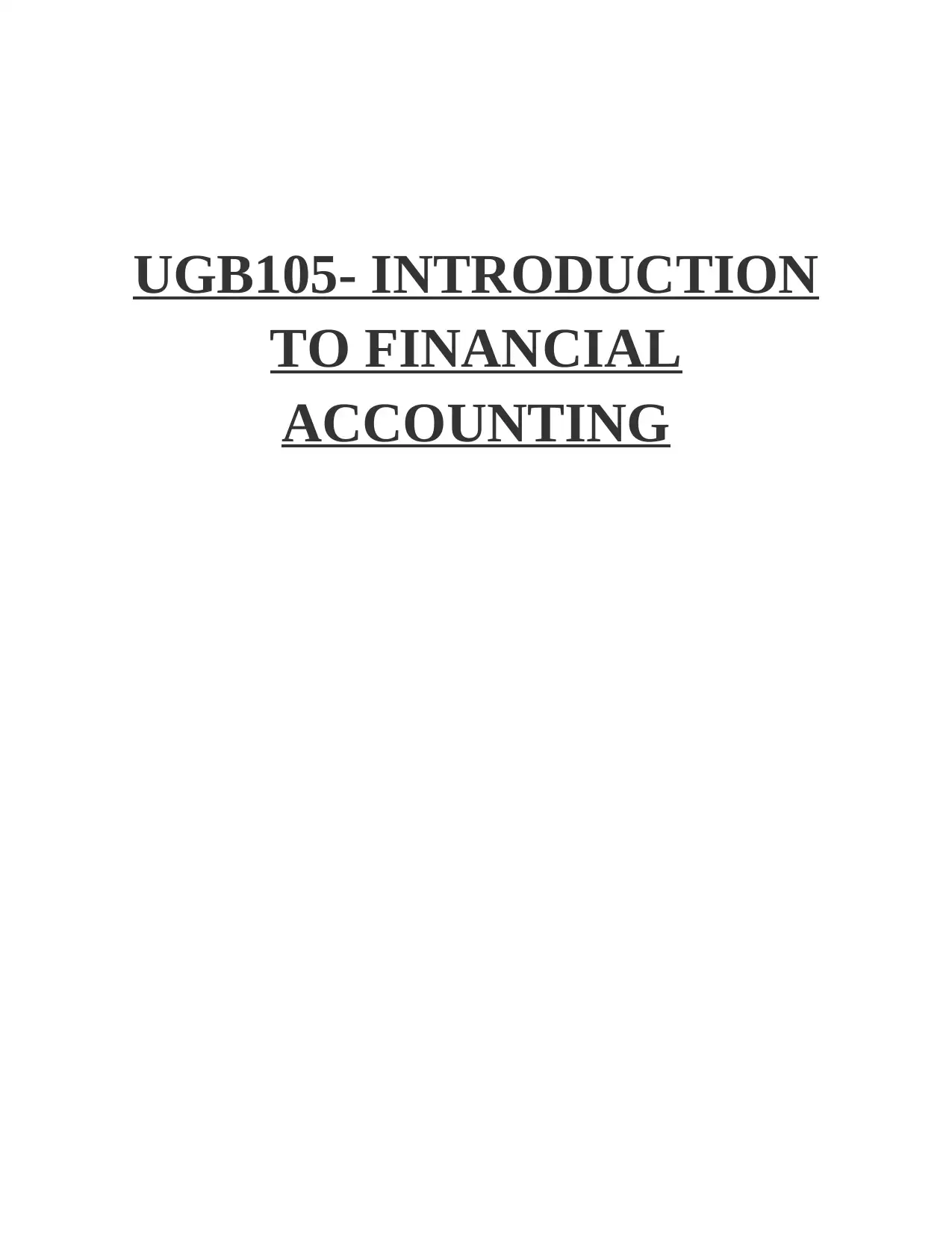
UGB105- INTRODUCTION
TO FINANCIAL
ACCOUNTING
TO FINANCIAL
ACCOUNTING
Paraphrase This Document
Need a fresh take? Get an instant paraphrase of this document with our AI Paraphraser
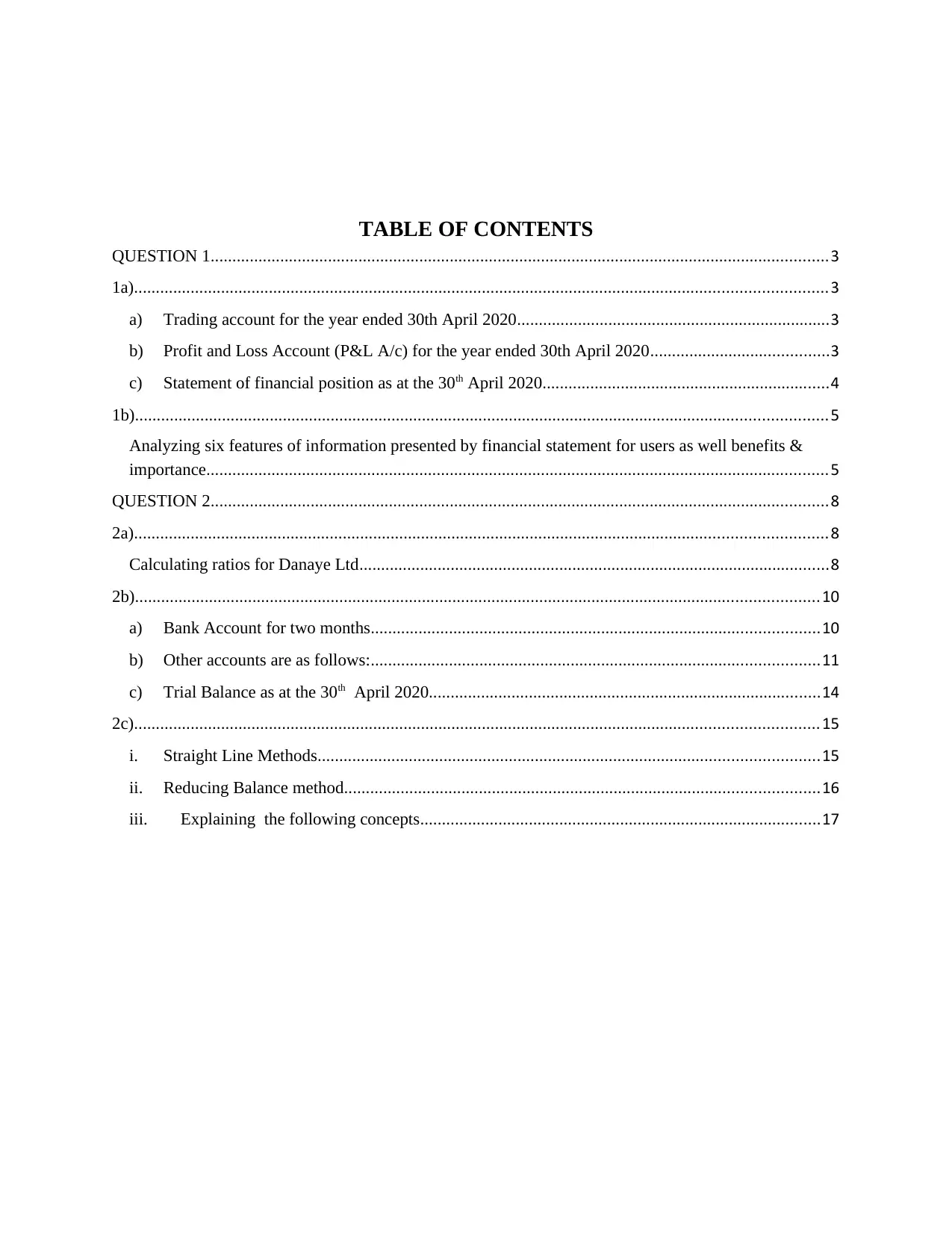
TABLE OF CONTENTS
QUESTION 1..............................................................................................................................................3
1a)...............................................................................................................................................................3
a) Trading account for the year ended 30th April 2020........................................................................3
b) Profit and Loss Account (P&L A/c) for the year ended 30th April 2020.........................................3
c) Statement of financial position as at the 30th April 2020..................................................................4
1b)...............................................................................................................................................................5
Analyzing six features of information presented by financial statement for users as well benefits &
importance...............................................................................................................................................5
QUESTION 2..............................................................................................................................................8
2a)...............................................................................................................................................................8
Calculating ratios for Danaye Ltd............................................................................................................8
2b).............................................................................................................................................................10
a) Bank Account for two months.......................................................................................................10
b) Other accounts are as follows:.......................................................................................................11
c) Trial Balance as at the 30th April 2020..........................................................................................14
2c).............................................................................................................................................................15
i. Straight Line Methods...................................................................................................................15
ii. Reducing Balance method.............................................................................................................16
iii. Explaining the following concepts............................................................................................17
QUESTION 1..............................................................................................................................................3
1a)...............................................................................................................................................................3
a) Trading account for the year ended 30th April 2020........................................................................3
b) Profit and Loss Account (P&L A/c) for the year ended 30th April 2020.........................................3
c) Statement of financial position as at the 30th April 2020..................................................................4
1b)...............................................................................................................................................................5
Analyzing six features of information presented by financial statement for users as well benefits &
importance...............................................................................................................................................5
QUESTION 2..............................................................................................................................................8
2a)...............................................................................................................................................................8
Calculating ratios for Danaye Ltd............................................................................................................8
2b).............................................................................................................................................................10
a) Bank Account for two months.......................................................................................................10
b) Other accounts are as follows:.......................................................................................................11
c) Trial Balance as at the 30th April 2020..........................................................................................14
2c).............................................................................................................................................................15
i. Straight Line Methods...................................................................................................................15
ii. Reducing Balance method.............................................................................................................16
iii. Explaining the following concepts............................................................................................17
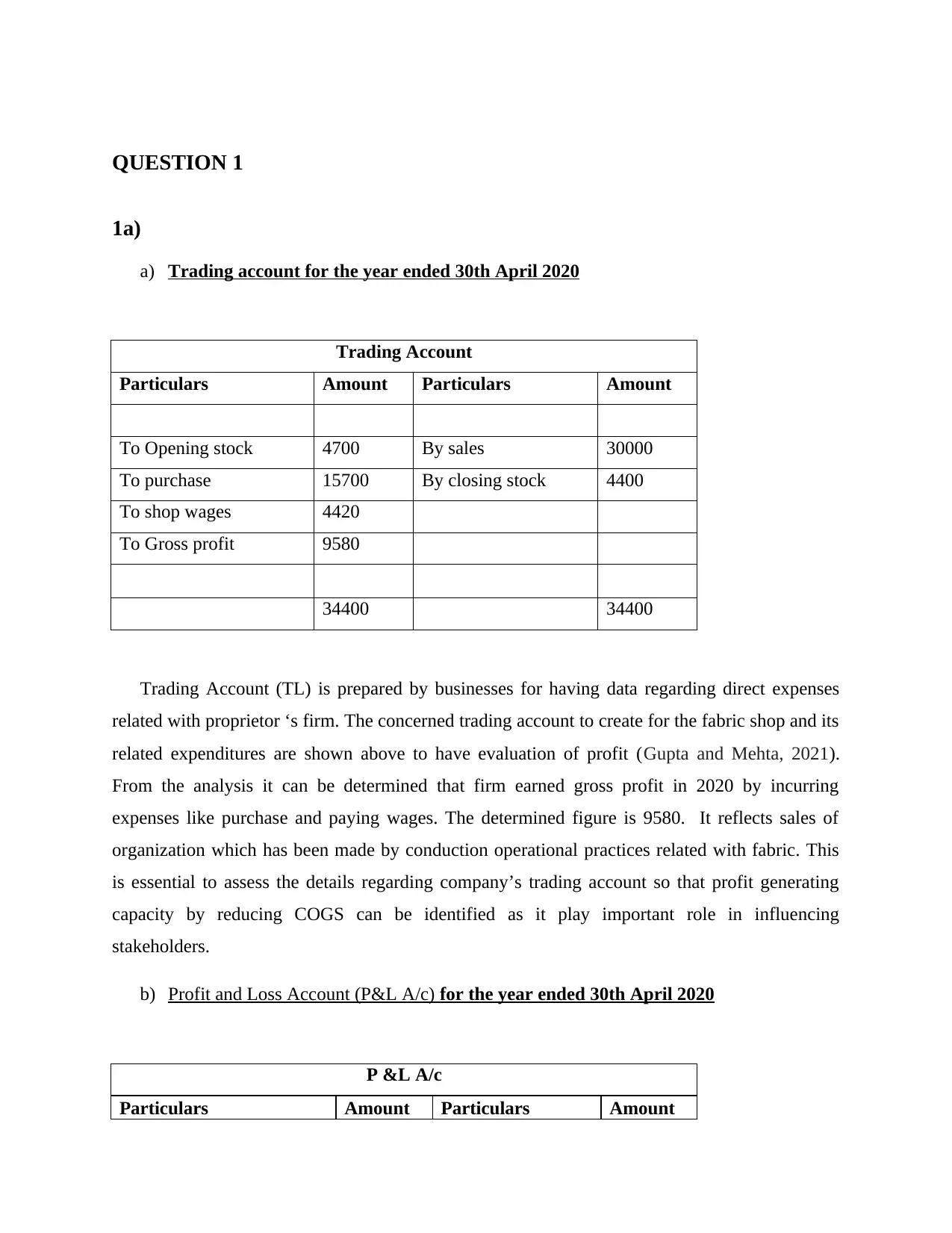
QUESTION 1
1a)
a) Trading account for the year ended 30th April 2020
Trading Account
Particulars Amount Particulars Amount
To Opening stock 4700 By sales 30000
To purchase 15700 By closing stock 4400
To shop wages 4420
To Gross profit 9580
34400 34400
Trading Account (TL) is prepared by businesses for having data regarding direct expenses
related with proprietor ‘s firm. The concerned trading account to create for the fabric shop and its
related expenditures are shown above to have evaluation of profit (Gupta and Mehta, 2021).
From the analysis it can be determined that firm earned gross profit in 2020 by incurring
expenses like purchase and paying wages. The determined figure is 9580. It reflects sales of
organization which has been made by conduction operational practices related with fabric. This
is essential to assess the details regarding company’s trading account so that profit generating
capacity by reducing COGS can be identified as it play important role in influencing
stakeholders.
b) Profit and Loss Account (P&L A/c) for the year ended 30th April 2020
P &L A/c
Particulars Amount Particulars Amount
1a)
a) Trading account for the year ended 30th April 2020
Trading Account
Particulars Amount Particulars Amount
To Opening stock 4700 By sales 30000
To purchase 15700 By closing stock 4400
To shop wages 4420
To Gross profit 9580
34400 34400
Trading Account (TL) is prepared by businesses for having data regarding direct expenses
related with proprietor ‘s firm. The concerned trading account to create for the fabric shop and its
related expenditures are shown above to have evaluation of profit (Gupta and Mehta, 2021).
From the analysis it can be determined that firm earned gross profit in 2020 by incurring
expenses like purchase and paying wages. The determined figure is 9580. It reflects sales of
organization which has been made by conduction operational practices related with fabric. This
is essential to assess the details regarding company’s trading account so that profit generating
capacity by reducing COGS can be identified as it play important role in influencing
stakeholders.
b) Profit and Loss Account (P&L A/c) for the year ended 30th April 2020
P &L A/c
Particulars Amount Particulars Amount
⊘ This is a preview!⊘
Do you want full access?
Subscribe today to unlock all pages.

Trusted by 1+ million students worldwide
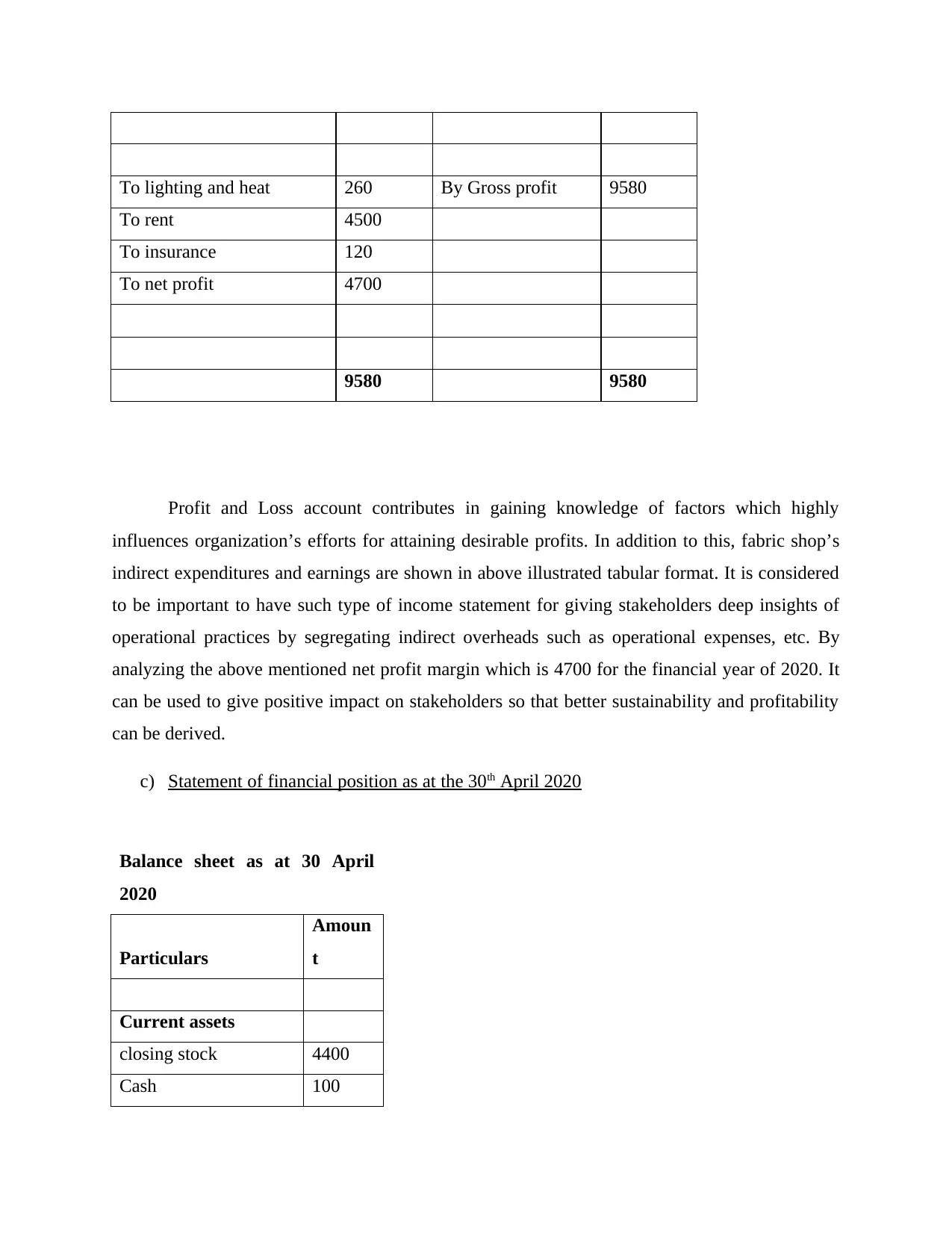
To lighting and heat 260 By Gross profit 9580
To rent 4500
To insurance 120
To net profit 4700
9580 9580
Profit and Loss account contributes in gaining knowledge of factors which highly
influences organization’s efforts for attaining desirable profits. In addition to this, fabric shop’s
indirect expenditures and earnings are shown in above illustrated tabular format. It is considered
to be important to have such type of income statement for giving stakeholders deep insights of
operational practices by segregating indirect overheads such as operational expenses, etc. By
analyzing the above mentioned net profit margin which is 4700 for the financial year of 2020. It
can be used to give positive impact on stakeholders so that better sustainability and profitability
can be derived.
c) Statement of financial position as at the 30th April 2020
Balance sheet as at 30 April
2020
Particulars
Amoun
t
Current assets
closing stock 4400
Cash 100
To rent 4500
To insurance 120
To net profit 4700
9580 9580
Profit and Loss account contributes in gaining knowledge of factors which highly
influences organization’s efforts for attaining desirable profits. In addition to this, fabric shop’s
indirect expenditures and earnings are shown in above illustrated tabular format. It is considered
to be important to have such type of income statement for giving stakeholders deep insights of
operational practices by segregating indirect overheads such as operational expenses, etc. By
analyzing the above mentioned net profit margin which is 4700 for the financial year of 2020. It
can be used to give positive impact on stakeholders so that better sustainability and profitability
can be derived.
c) Statement of financial position as at the 30th April 2020
Balance sheet as at 30 April
2020
Particulars
Amoun
t
Current assets
closing stock 4400
Cash 100
Paraphrase This Document
Need a fresh take? Get an instant paraphrase of this document with our AI Paraphraser
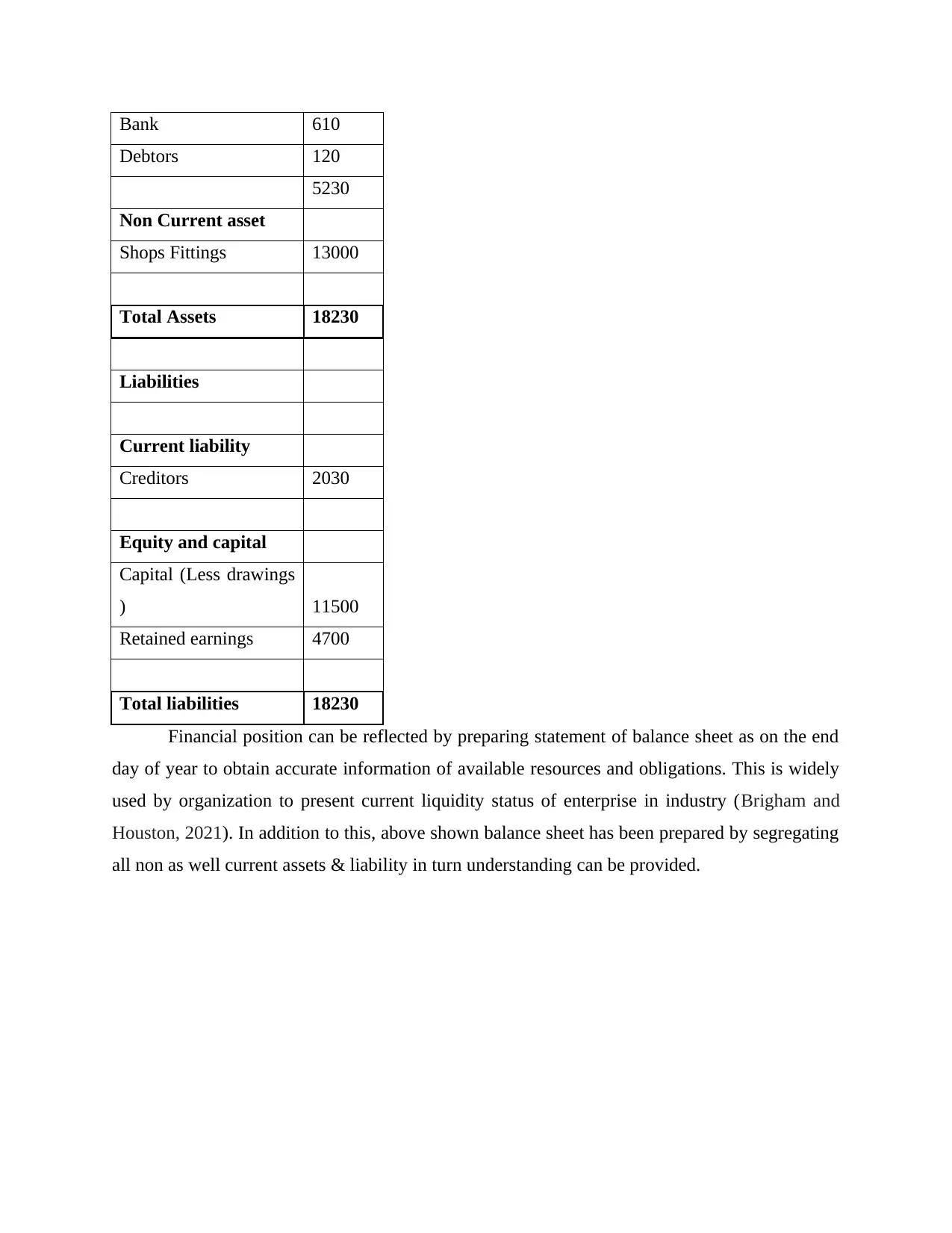
Bank 610
Debtors 120
5230
Non Current asset
Shops Fittings 13000
Total Assets 18230
Liabilities
Current liability
Creditors 2030
Equity and capital
Capital (Less drawings
) 11500
Retained earnings 4700
Total liabilities 18230
Financial position can be reflected by preparing statement of balance sheet as on the end
day of year to obtain accurate information of available resources and obligations. This is widely
used by organization to present current liquidity status of enterprise in industry (Brigham and
Houston, 2021). In addition to this, above shown balance sheet has been prepared by segregating
all non as well current assets & liability in turn understanding can be provided.
Debtors 120
5230
Non Current asset
Shops Fittings 13000
Total Assets 18230
Liabilities
Current liability
Creditors 2030
Equity and capital
Capital (Less drawings
) 11500
Retained earnings 4700
Total liabilities 18230
Financial position can be reflected by preparing statement of balance sheet as on the end
day of year to obtain accurate information of available resources and obligations. This is widely
used by organization to present current liquidity status of enterprise in industry (Brigham and
Houston, 2021). In addition to this, above shown balance sheet has been prepared by segregating
all non as well current assets & liability in turn understanding can be provided.
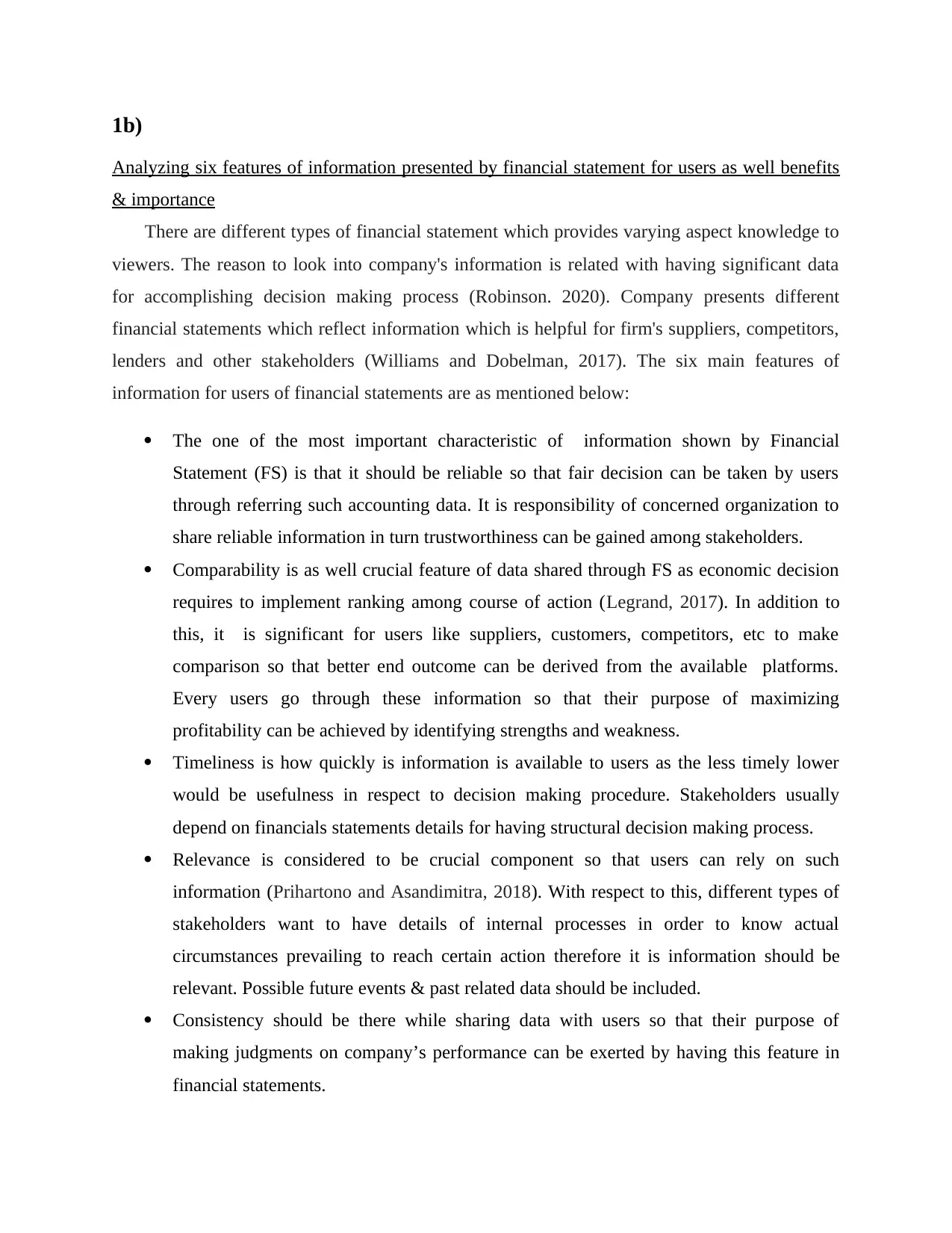
1b)
Analyzing six features of information presented by financial statement for users as well benefits
& importance
There are different types of financial statement which provides varying aspect knowledge to
viewers. The reason to look into company's information is related with having significant data
for accomplishing decision making process (Robinson. 2020). Company presents different
financial statements which reflect information which is helpful for firm's suppliers, competitors,
lenders and other stakeholders (Williams and Dobelman, 2017). The six main features of
information for users of financial statements are as mentioned below:
The one of the most important characteristic of information shown by Financial
Statement (FS) is that it should be reliable so that fair decision can be taken by users
through referring such accounting data. It is responsibility of concerned organization to
share reliable information in turn trustworthiness can be gained among stakeholders.
Comparability is as well crucial feature of data shared through FS as economic decision
requires to implement ranking among course of action (Legrand, 2017). In addition to
this, it is significant for users like suppliers, customers, competitors, etc to make
comparison so that better end outcome can be derived from the available platforms.
Every users go through these information so that their purpose of maximizing
profitability can be achieved by identifying strengths and weakness.
Timeliness is how quickly is information is available to users as the less timely lower
would be usefulness in respect to decision making procedure. Stakeholders usually
depend on financials statements details for having structural decision making process.
Relevance is considered to be crucial component so that users can rely on such
information (Prihartono and Asandimitra, 2018). With respect to this, different types of
stakeholders want to have details of internal processes in order to know actual
circumstances prevailing to reach certain action therefore it is information should be
relevant. Possible future events & past related data should be included.
Consistency should be there while sharing data with users so that their purpose of
making judgments on company’s performance can be exerted by having this feature in
financial statements.
Analyzing six features of information presented by financial statement for users as well benefits
& importance
There are different types of financial statement which provides varying aspect knowledge to
viewers. The reason to look into company's information is related with having significant data
for accomplishing decision making process (Robinson. 2020). Company presents different
financial statements which reflect information which is helpful for firm's suppliers, competitors,
lenders and other stakeholders (Williams and Dobelman, 2017). The six main features of
information for users of financial statements are as mentioned below:
The one of the most important characteristic of information shown by Financial
Statement (FS) is that it should be reliable so that fair decision can be taken by users
through referring such accounting data. It is responsibility of concerned organization to
share reliable information in turn trustworthiness can be gained among stakeholders.
Comparability is as well crucial feature of data shared through FS as economic decision
requires to implement ranking among course of action (Legrand, 2017). In addition to
this, it is significant for users like suppliers, customers, competitors, etc to make
comparison so that better end outcome can be derived from the available platforms.
Every users go through these information so that their purpose of maximizing
profitability can be achieved by identifying strengths and weakness.
Timeliness is how quickly is information is available to users as the less timely lower
would be usefulness in respect to decision making procedure. Stakeholders usually
depend on financials statements details for having structural decision making process.
Relevance is considered to be crucial component so that users can rely on such
information (Prihartono and Asandimitra, 2018). With respect to this, different types of
stakeholders want to have details of internal processes in order to know actual
circumstances prevailing to reach certain action therefore it is information should be
relevant. Possible future events & past related data should be included.
Consistency should be there while sharing data with users so that their purpose of
making judgments on company’s performance can be exerted by having this feature in
financial statements.
⊘ This is a preview!⊘
Do you want full access?
Subscribe today to unlock all pages.

Trusted by 1+ million students worldwide
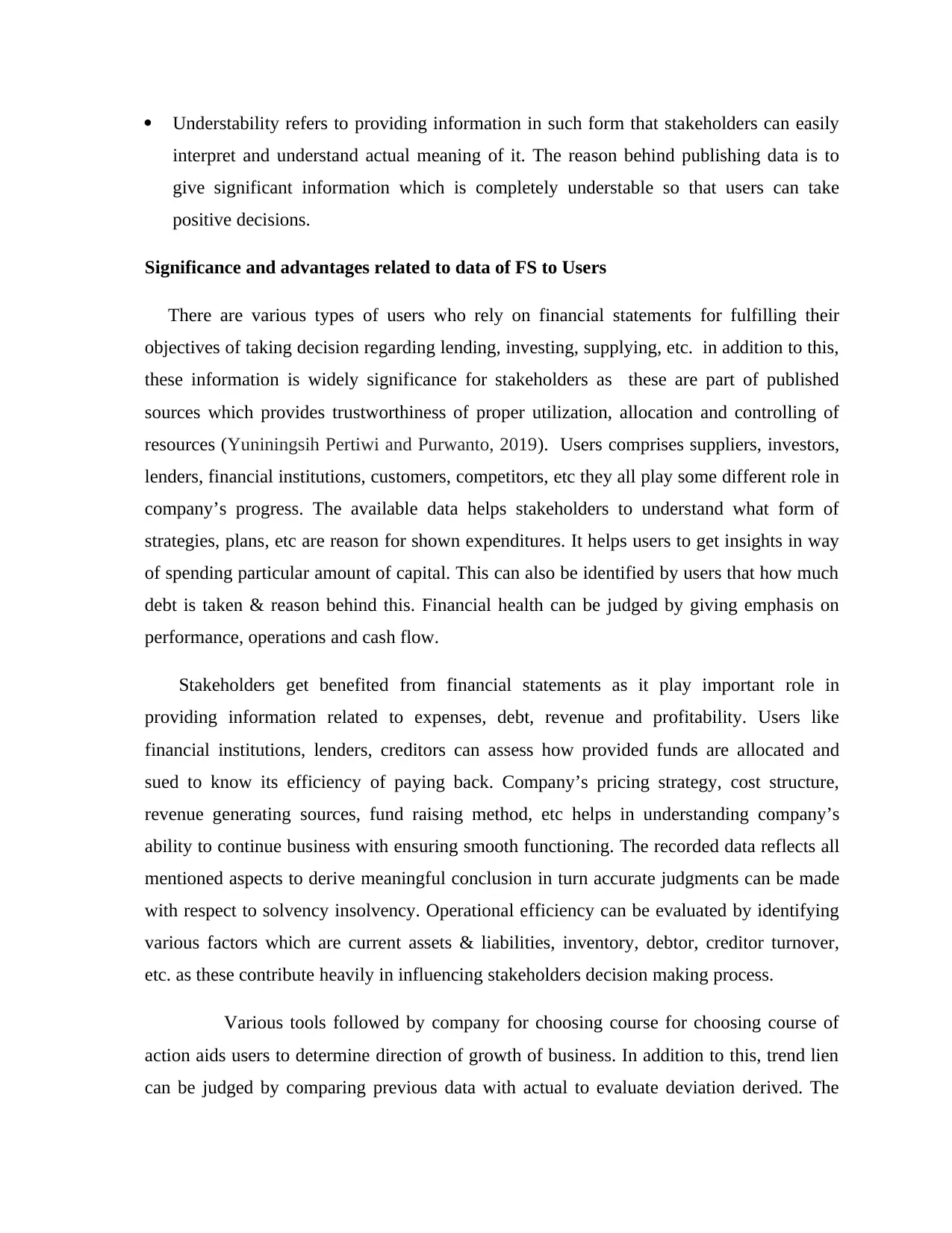
Understability refers to providing information in such form that stakeholders can easily
interpret and understand actual meaning of it. The reason behind publishing data is to
give significant information which is completely understable so that users can take
positive decisions.
Significance and advantages related to data of FS to Users
There are various types of users who rely on financial statements for fulfilling their
objectives of taking decision regarding lending, investing, supplying, etc. in addition to this,
these information is widely significance for stakeholders as these are part of published
sources which provides trustworthiness of proper utilization, allocation and controlling of
resources (Yuniningsih Pertiwi and Purwanto, 2019). Users comprises suppliers, investors,
lenders, financial institutions, customers, competitors, etc they all play some different role in
company’s progress. The available data helps stakeholders to understand what form of
strategies, plans, etc are reason for shown expenditures. It helps users to get insights in way
of spending particular amount of capital. This can also be identified by users that how much
debt is taken & reason behind this. Financial health can be judged by giving emphasis on
performance, operations and cash flow.
Stakeholders get benefited from financial statements as it play important role in
providing information related to expenses, debt, revenue and profitability. Users like
financial institutions, lenders, creditors can assess how provided funds are allocated and
sued to know its efficiency of paying back. Company’s pricing strategy, cost structure,
revenue generating sources, fund raising method, etc helps in understanding company’s
ability to continue business with ensuring smooth functioning. The recorded data reflects all
mentioned aspects to derive meaningful conclusion in turn accurate judgments can be made
with respect to solvency insolvency. Operational efficiency can be evaluated by identifying
various factors which are current assets & liabilities, inventory, debtor, creditor turnover,
etc. as these contribute heavily in influencing stakeholders decision making process.
Various tools followed by company for choosing course for choosing course of
action aids users to determine direction of growth of business. In addition to this, trend lien
can be judged by comparing previous data with actual to evaluate deviation derived. The
interpret and understand actual meaning of it. The reason behind publishing data is to
give significant information which is completely understable so that users can take
positive decisions.
Significance and advantages related to data of FS to Users
There are various types of users who rely on financial statements for fulfilling their
objectives of taking decision regarding lending, investing, supplying, etc. in addition to this,
these information is widely significance for stakeholders as these are part of published
sources which provides trustworthiness of proper utilization, allocation and controlling of
resources (Yuniningsih Pertiwi and Purwanto, 2019). Users comprises suppliers, investors,
lenders, financial institutions, customers, competitors, etc they all play some different role in
company’s progress. The available data helps stakeholders to understand what form of
strategies, plans, etc are reason for shown expenditures. It helps users to get insights in way
of spending particular amount of capital. This can also be identified by users that how much
debt is taken & reason behind this. Financial health can be judged by giving emphasis on
performance, operations and cash flow.
Stakeholders get benefited from financial statements as it play important role in
providing information related to expenses, debt, revenue and profitability. Users like
financial institutions, lenders, creditors can assess how provided funds are allocated and
sued to know its efficiency of paying back. Company’s pricing strategy, cost structure,
revenue generating sources, fund raising method, etc helps in understanding company’s
ability to continue business with ensuring smooth functioning. The recorded data reflects all
mentioned aspects to derive meaningful conclusion in turn accurate judgments can be made
with respect to solvency insolvency. Operational efficiency can be evaluated by identifying
various factors which are current assets & liabilities, inventory, debtor, creditor turnover,
etc. as these contribute heavily in influencing stakeholders decision making process.
Various tools followed by company for choosing course for choosing course of
action aids users to determine direction of growth of business. In addition to this, trend lien
can be judged by comparing previous data with actual to evaluate deviation derived. The
Paraphrase This Document
Need a fresh take? Get an instant paraphrase of this document with our AI Paraphraser
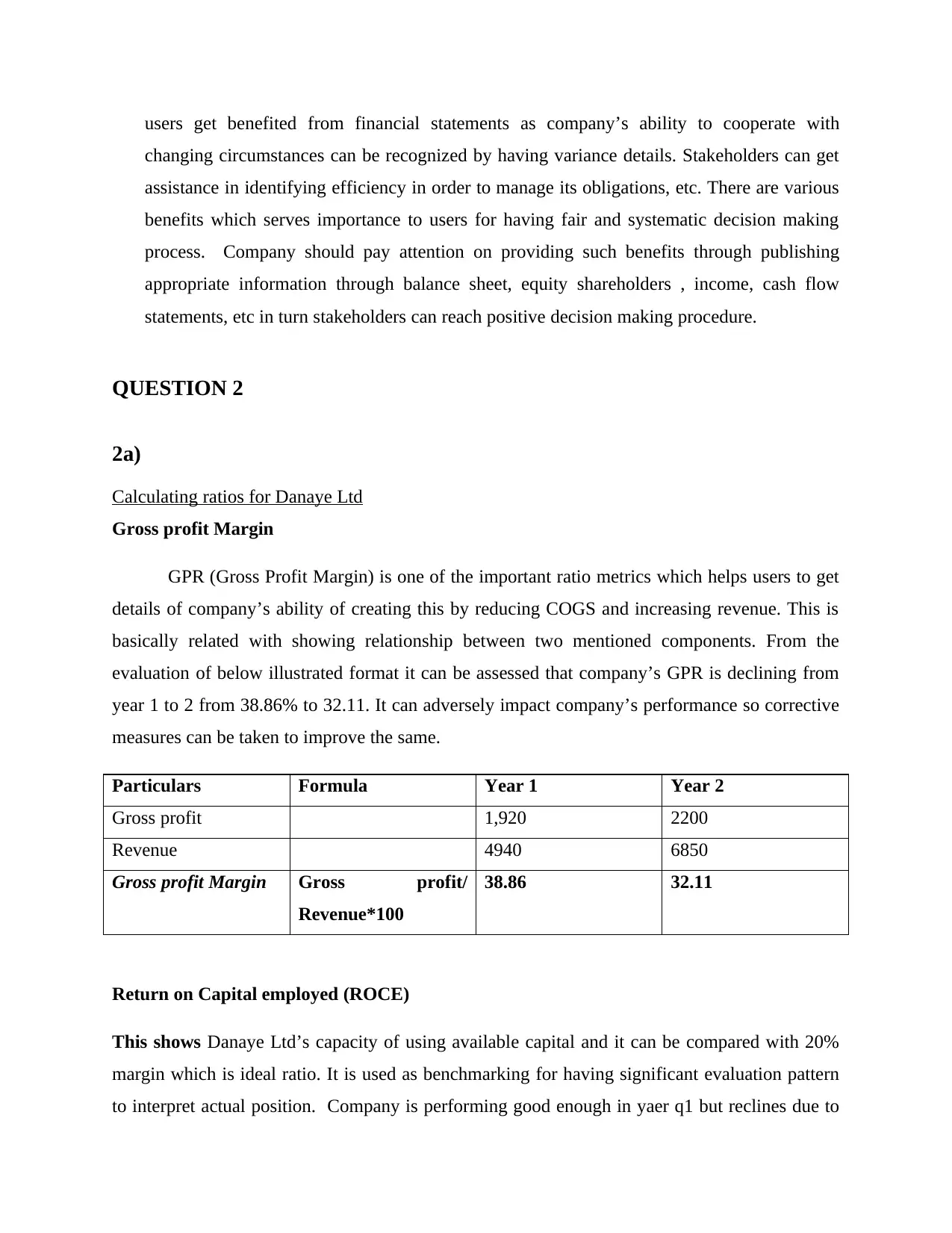
users get benefited from financial statements as company’s ability to cooperate with
changing circumstances can be recognized by having variance details. Stakeholders can get
assistance in identifying efficiency in order to manage its obligations, etc. There are various
benefits which serves importance to users for having fair and systematic decision making
process. Company should pay attention on providing such benefits through publishing
appropriate information through balance sheet, equity shareholders , income, cash flow
statements, etc in turn stakeholders can reach positive decision making procedure.
QUESTION 2
2a)
Calculating ratios for Danaye Ltd
Gross profit Margin
GPR (Gross Profit Margin) is one of the important ratio metrics which helps users to get
details of company’s ability of creating this by reducing COGS and increasing revenue. This is
basically related with showing relationship between two mentioned components. From the
evaluation of below illustrated format it can be assessed that company’s GPR is declining from
year 1 to 2 from 38.86% to 32.11. It can adversely impact company’s performance so corrective
measures can be taken to improve the same.
Particulars Formula Year 1 Year 2
Gross profit 1,920 2200
Revenue 4940 6850
Gross profit Margin Gross profit/
Revenue*100
38.86 32.11
Return on Capital employed (ROCE)
This shows Danaye Ltd’s capacity of using available capital and it can be compared with 20%
margin which is ideal ratio. It is used as benchmarking for having significant evaluation pattern
to interpret actual position. Company is performing good enough in yaer q1 but reclines due to
changing circumstances can be recognized by having variance details. Stakeholders can get
assistance in identifying efficiency in order to manage its obligations, etc. There are various
benefits which serves importance to users for having fair and systematic decision making
process. Company should pay attention on providing such benefits through publishing
appropriate information through balance sheet, equity shareholders , income, cash flow
statements, etc in turn stakeholders can reach positive decision making procedure.
QUESTION 2
2a)
Calculating ratios for Danaye Ltd
Gross profit Margin
GPR (Gross Profit Margin) is one of the important ratio metrics which helps users to get
details of company’s ability of creating this by reducing COGS and increasing revenue. This is
basically related with showing relationship between two mentioned components. From the
evaluation of below illustrated format it can be assessed that company’s GPR is declining from
year 1 to 2 from 38.86% to 32.11. It can adversely impact company’s performance so corrective
measures can be taken to improve the same.
Particulars Formula Year 1 Year 2
Gross profit 1,920 2200
Revenue 4940 6850
Gross profit Margin Gross profit/
Revenue*100
38.86 32.11
Return on Capital employed (ROCE)
This shows Danaye Ltd’s capacity of using available capital and it can be compared with 20%
margin which is ideal ratio. It is used as benchmarking for having significant evaluation pattern
to interpret actual position. Company is performing good enough in yaer q1 but reclines due to
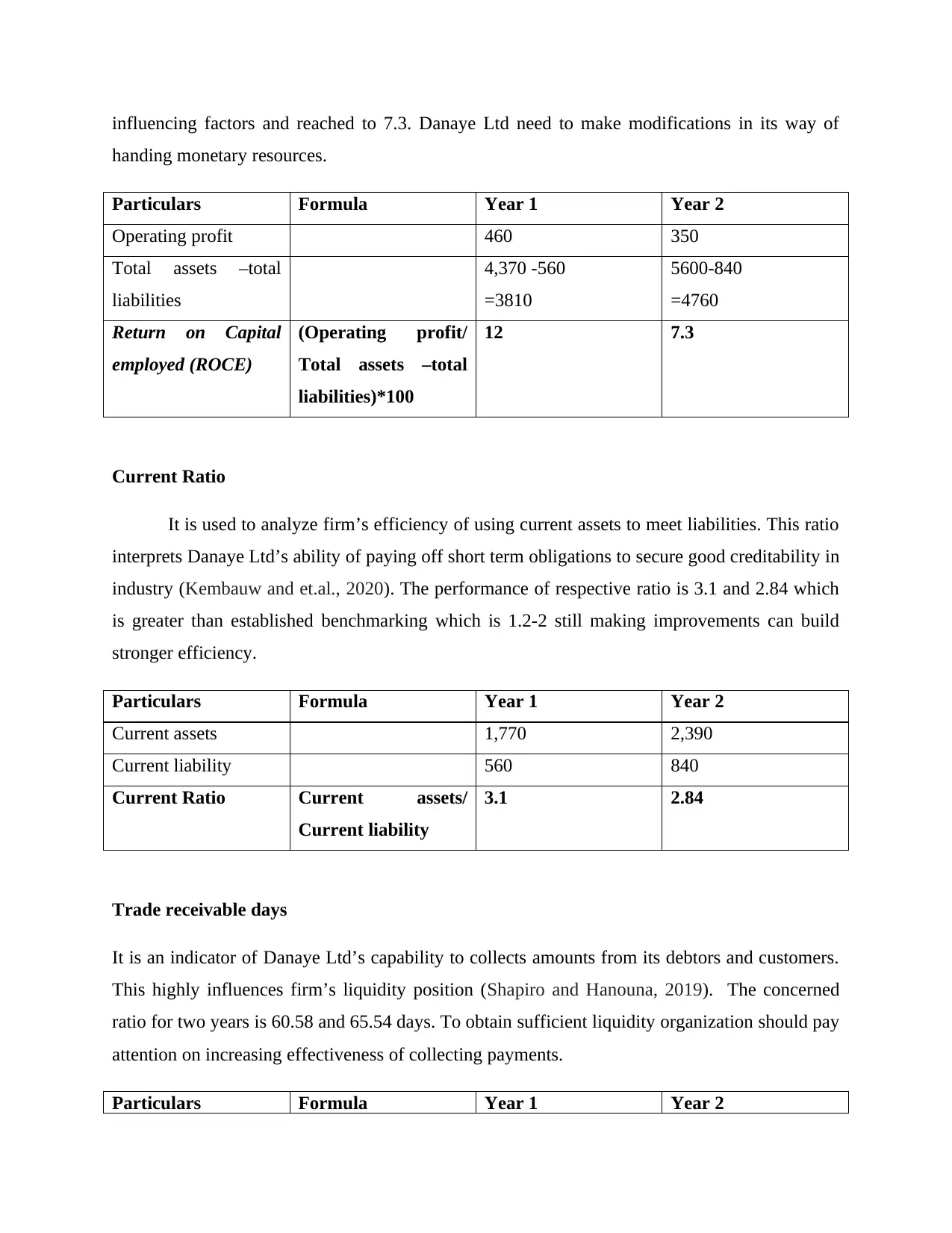
influencing factors and reached to 7.3. Danaye Ltd need to make modifications in its way of
handing monetary resources.
Particulars Formula Year 1 Year 2
Operating profit 460 350
Total assets –total
liabilities
4,370 -560
=3810
5600-840
=4760
Return on Capital
employed (ROCE)
(Operating profit/
Total assets –total
liabilities)*100
12 7.3
Current Ratio
It is used to analyze firm’s efficiency of using current assets to meet liabilities. This ratio
interprets Danaye Ltd’s ability of paying off short term obligations to secure good creditability in
industry (Kembauw and et.al., 2020). The performance of respective ratio is 3.1 and 2.84 which
is greater than established benchmarking which is 1.2-2 still making improvements can build
stronger efficiency.
Particulars Formula Year 1 Year 2
Current assets 1,770 2,390
Current liability 560 840
Current Ratio Current assets/
Current liability
3.1 2.84
Trade receivable days
It is an indicator of Danaye Ltd’s capability to collects amounts from its debtors and customers.
This highly influences firm’s liquidity position (Shapiro and Hanouna, 2019). The concerned
ratio for two years is 60.58 and 65.54 days. To obtain sufficient liquidity organization should pay
attention on increasing effectiveness of collecting payments.
Particulars Formula Year 1 Year 2
handing monetary resources.
Particulars Formula Year 1 Year 2
Operating profit 460 350
Total assets –total
liabilities
4,370 -560
=3810
5600-840
=4760
Return on Capital
employed (ROCE)
(Operating profit/
Total assets –total
liabilities)*100
12 7.3
Current Ratio
It is used to analyze firm’s efficiency of using current assets to meet liabilities. This ratio
interprets Danaye Ltd’s ability of paying off short term obligations to secure good creditability in
industry (Kembauw and et.al., 2020). The performance of respective ratio is 3.1 and 2.84 which
is greater than established benchmarking which is 1.2-2 still making improvements can build
stronger efficiency.
Particulars Formula Year 1 Year 2
Current assets 1,770 2,390
Current liability 560 840
Current Ratio Current assets/
Current liability
3.1 2.84
Trade receivable days
It is an indicator of Danaye Ltd’s capability to collects amounts from its debtors and customers.
This highly influences firm’s liquidity position (Shapiro and Hanouna, 2019). The concerned
ratio for two years is 60.58 and 65.54 days. To obtain sufficient liquidity organization should pay
attention on increasing effectiveness of collecting payments.
Particulars Formula Year 1 Year 2
⊘ This is a preview!⊘
Do you want full access?
Subscribe today to unlock all pages.

Trusted by 1+ million students worldwide
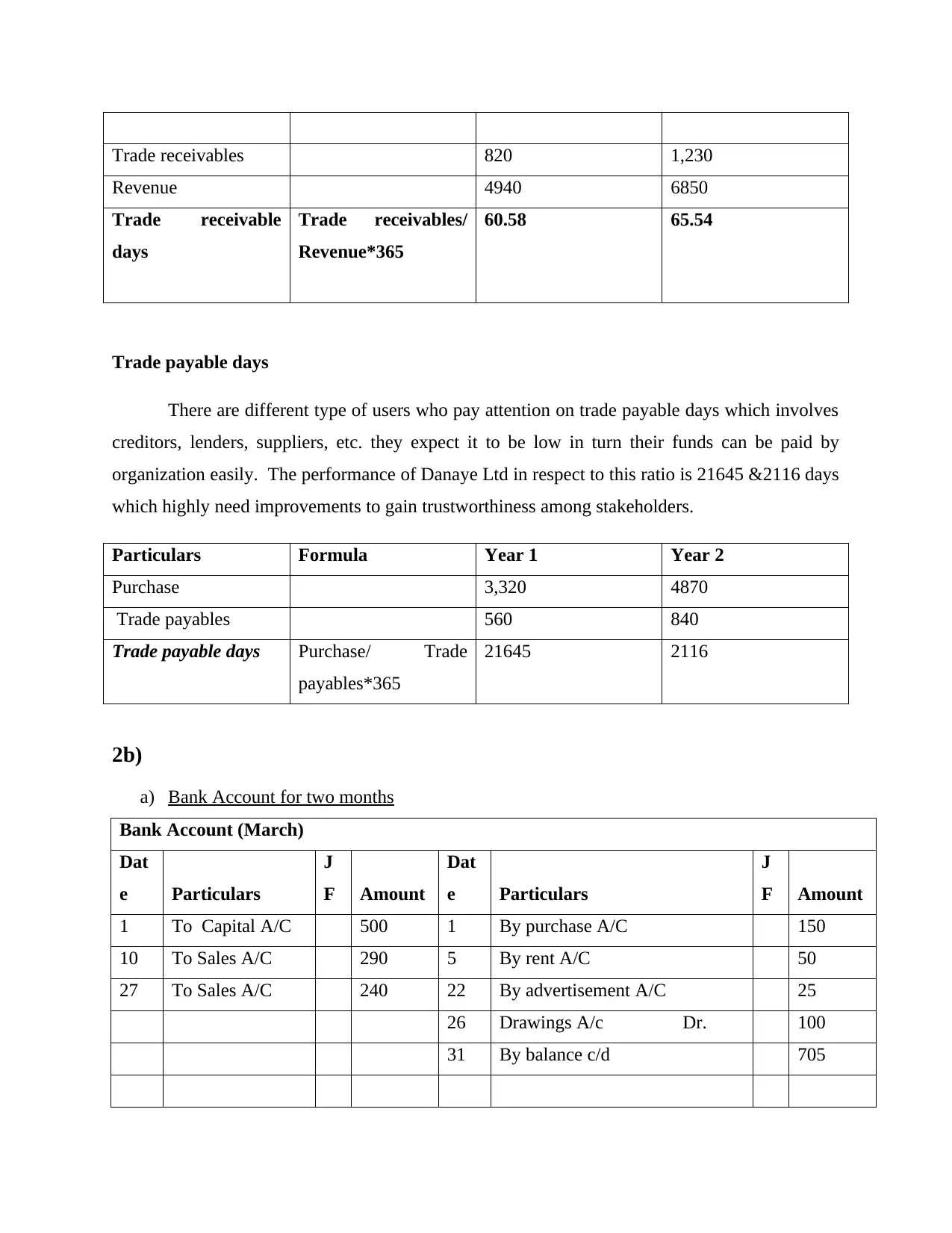
Trade receivables 820 1,230
Revenue 4940 6850
Trade receivable
days
Trade receivables/
Revenue*365
60.58 65.54
Trade payable days
There are different type of users who pay attention on trade payable days which involves
creditors, lenders, suppliers, etc. they expect it to be low in turn their funds can be paid by
organization easily. The performance of Danaye Ltd in respect to this ratio is 21645 &2116 days
which highly need improvements to gain trustworthiness among stakeholders.
Particulars Formula Year 1 Year 2
Purchase 3,320 4870
Trade payables 560 840
Trade payable days Purchase/ Trade
payables*365
21645 2116
2b)
a) Bank Account for two months
Bank Account (March)
Dat
e Particulars
J
F Amount
Dat
e Particulars
J
F Amount
1 To Capital A/C 500 1 By purchase A/C 150
10 To Sales A/C 290 5 By rent A/C 50
27 To Sales A/C 240 22 By advertisement A/C 25
26 Drawings A/c Dr. 100
31 By balance c/d 705
Revenue 4940 6850
Trade receivable
days
Trade receivables/
Revenue*365
60.58 65.54
Trade payable days
There are different type of users who pay attention on trade payable days which involves
creditors, lenders, suppliers, etc. they expect it to be low in turn their funds can be paid by
organization easily. The performance of Danaye Ltd in respect to this ratio is 21645 &2116 days
which highly need improvements to gain trustworthiness among stakeholders.
Particulars Formula Year 1 Year 2
Purchase 3,320 4870
Trade payables 560 840
Trade payable days Purchase/ Trade
payables*365
21645 2116
2b)
a) Bank Account for two months
Bank Account (March)
Dat
e Particulars
J
F Amount
Dat
e Particulars
J
F Amount
1 To Capital A/C 500 1 By purchase A/C 150
10 To Sales A/C 290 5 By rent A/C 50
27 To Sales A/C 240 22 By advertisement A/C 25
26 Drawings A/c Dr. 100
31 By balance c/d 705
Paraphrase This Document
Need a fresh take? Get an instant paraphrase of this document with our AI Paraphraser
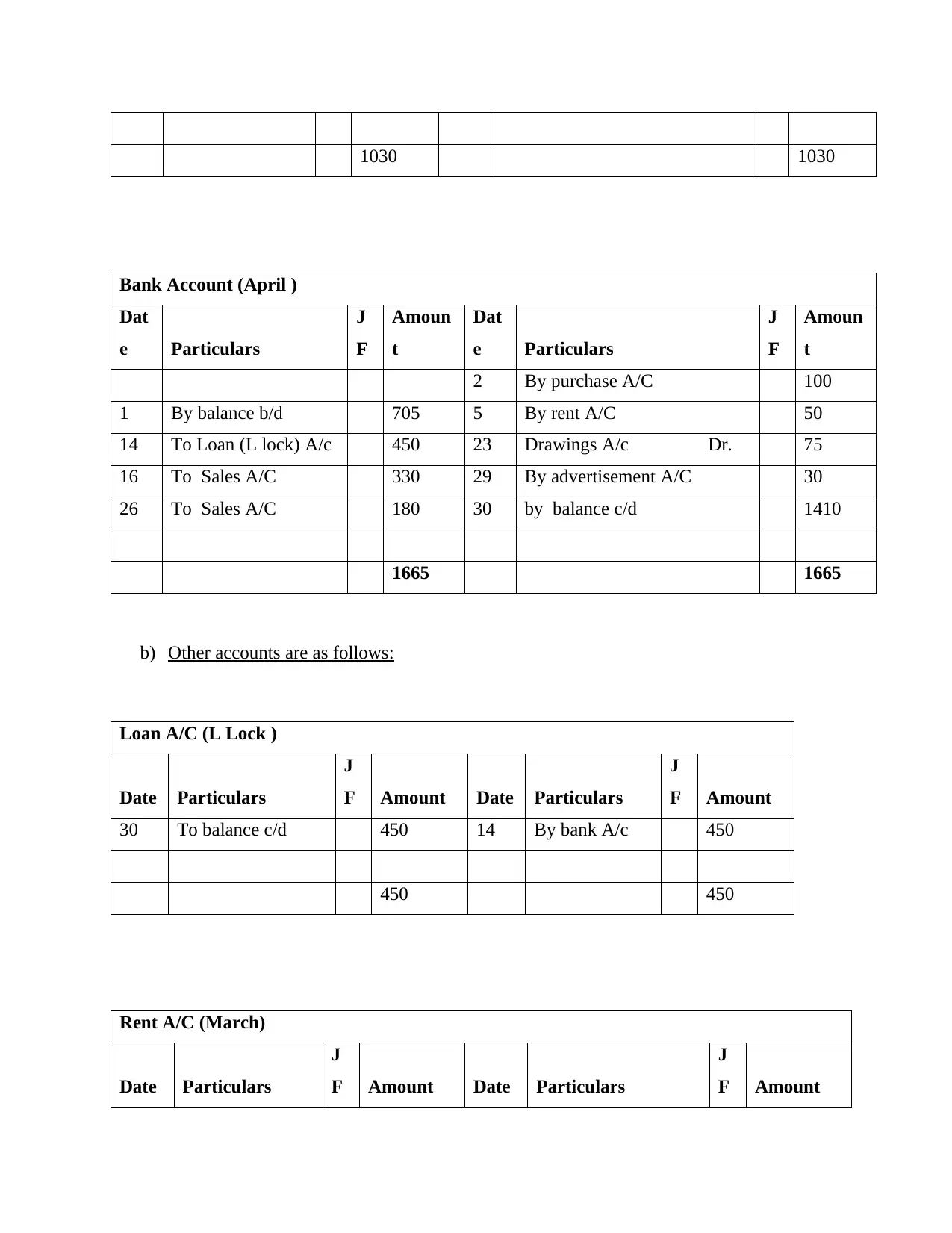
1030 1030
Bank Account (April )
Dat
e Particulars
J
F
Amoun
t
Dat
e Particulars
J
F
Amoun
t
2 By purchase A/C 100
1 By balance b/d 705 5 By rent A/C 50
14 To Loan (L lock) A/c 450 23 Drawings A/c Dr. 75
16 To Sales A/C 330 29 By advertisement A/C 30
26 To Sales A/C 180 30 by balance c/d 1410
1665 1665
b) Other accounts are as follows:
Loan A/C (L Lock )
Date Particulars
J
F Amount Date Particulars
J
F Amount
30 To balance c/d 450 14 By bank A/c 450
450 450
Rent A/C (March)
Date Particulars
J
F Amount Date Particulars
J
F Amount
Bank Account (April )
Dat
e Particulars
J
F
Amoun
t
Dat
e Particulars
J
F
Amoun
t
2 By purchase A/C 100
1 By balance b/d 705 5 By rent A/C 50
14 To Loan (L lock) A/c 450 23 Drawings A/c Dr. 75
16 To Sales A/C 330 29 By advertisement A/C 30
26 To Sales A/C 180 30 by balance c/d 1410
1665 1665
b) Other accounts are as follows:
Loan A/C (L Lock )
Date Particulars
J
F Amount Date Particulars
J
F Amount
30 To balance c/d 450 14 By bank A/c 450
450 450
Rent A/C (March)
Date Particulars
J
F Amount Date Particulars
J
F Amount
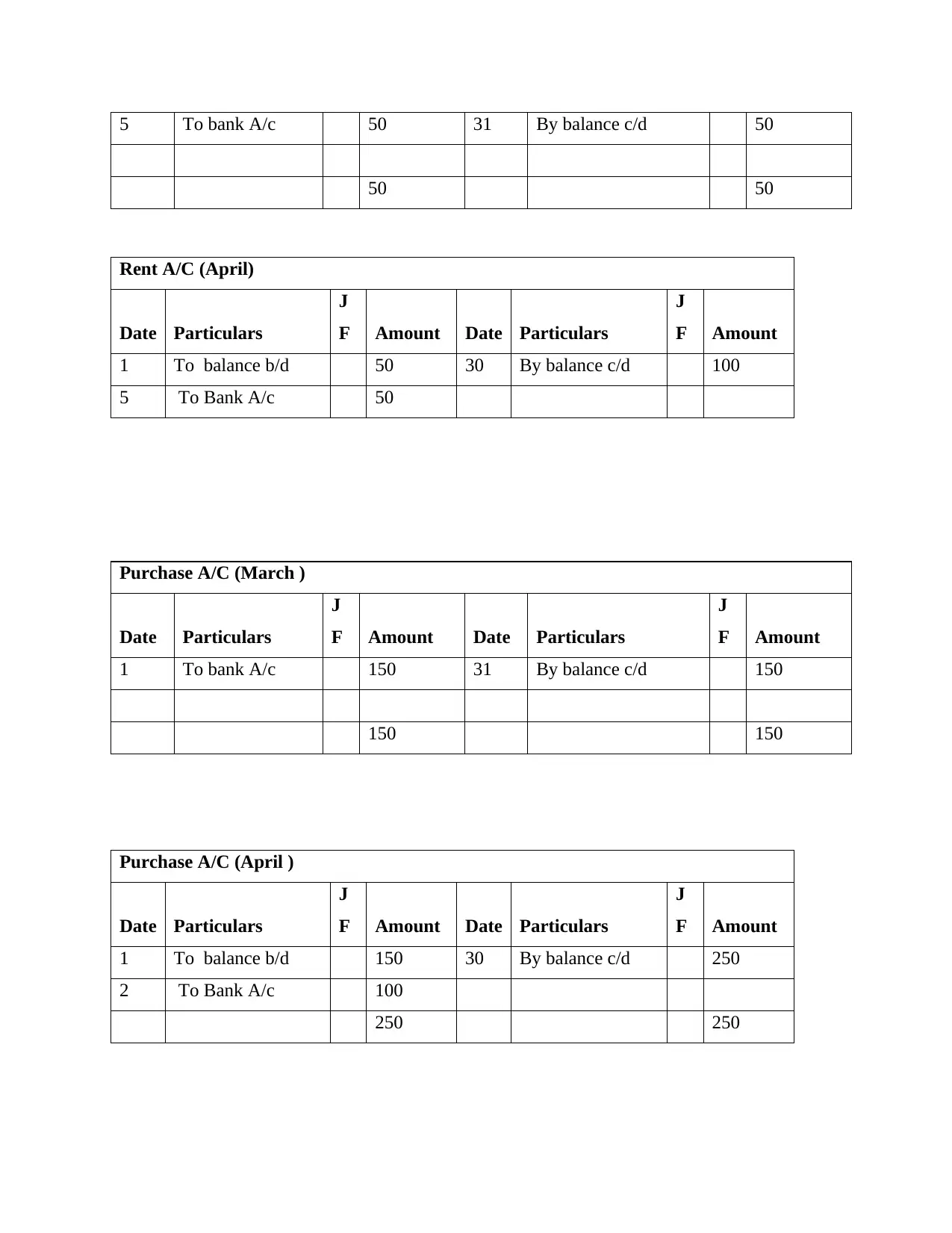
5 To bank A/c 50 31 By balance c/d 50
50 50
Rent A/C (April)
Date Particulars
J
F Amount Date Particulars
J
F Amount
1 To balance b/d 50 30 By balance c/d 100
5 To Bank A/c 50
Purchase A/C (March )
Date Particulars
J
F Amount Date Particulars
J
F Amount
1 To bank A/c 150 31 By balance c/d 150
150 150
Purchase A/C (April )
Date Particulars
J
F Amount Date Particulars
J
F Amount
1 To balance b/d 150 30 By balance c/d 250
2 To Bank A/c 100
250 250
50 50
Rent A/C (April)
Date Particulars
J
F Amount Date Particulars
J
F Amount
1 To balance b/d 50 30 By balance c/d 100
5 To Bank A/c 50
Purchase A/C (March )
Date Particulars
J
F Amount Date Particulars
J
F Amount
1 To bank A/c 150 31 By balance c/d 150
150 150
Purchase A/C (April )
Date Particulars
J
F Amount Date Particulars
J
F Amount
1 To balance b/d 150 30 By balance c/d 250
2 To Bank A/c 100
250 250
⊘ This is a preview!⊘
Do you want full access?
Subscribe today to unlock all pages.

Trusted by 1+ million students worldwide
1 out of 19
Related Documents
Your All-in-One AI-Powered Toolkit for Academic Success.
+13062052269
info@desklib.com
Available 24*7 on WhatsApp / Email
![[object Object]](/_next/static/media/star-bottom.7253800d.svg)
Unlock your academic potential
Copyright © 2020–2025 A2Z Services. All Rights Reserved. Developed and managed by ZUCOL.





